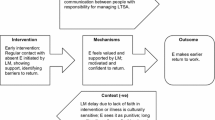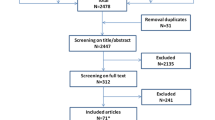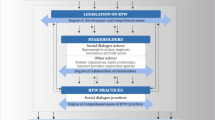Abstract
Purpose The increasing impact and costs of long term sickness absence have been well documented. However, the diversity and complexity of interventions and of the contexts in which these take place makes a traditional review problematic. Therefore, we undertook a systematic realist review to identify the dominant programme theories underlying best practice, to assess the evidence for these theories, and to throw light on important enabling or disabling contextual factors. Method A search of the scholarly literature from 1950 to 2011 identified 5,576 articles, of which 269 formed the basis of the review. Results We found that the dominant programme theories in relation to effective management related to: early intervention or referral by employers; having proactive organisational procedures; good communication and cooperation between stakeholders; and workplace-based occupational rehabilitation. Significant contextual factors were identified as the level of support for interventions from top management, the size and structure of the organisation, the level of financial and organisational investment in the management of long-term sickness absence, and the quality of relationships between managers and staff. Conclusions Consequently, those with responsibility for managing absence should bear in mind the contextual factors that are likely to have an impact on interventions, and do what they can to ensure stakeholders have at least a mutual understanding (if not a common purpose) in relation to their perceptions of interventions, goals, culture and practice in the management of long term sickness absence.

Similar content being viewed by others
References
Evans A, Walters M. From absence to attendance. 2nd ed. London: Chartered Institute of Personnel and Development; 2003.
Dibben P, James P, Cunningham I. Absence management in the public sector: an integrative model? Public Money Manag. 2001;21(4):55–60.
Chartered British Institute, CBI On the path to recovery. Absence and Workplace Health Survey 2010, www.cbi.org.uk. Accessed 01 Apr 2011.
James P, Cunningham I, Dibben P. Job retention and return to work of ill and injured workers: towards an understanding of the organisational dynamics. Employ Relat. 2006;28(3):290–303.
Black C. Working for a healthier tomorrow: review of the heath of working age population. London: Department of Work and Pensions; 2008.
National Institute for Health and Clinical Excellence (NICE). Managing long-term sickness absence and incapacity for Work. Public Health Guidance 19; 2009.
Waddell G, Burton K. Concepts of rehabilitation for the management of low back pain. Best Pract Res Clin Rheumatol. 2005;119(4):655–70.
Munir F, Yarker J, Haslam C. Sickness absence management: encouraging attendance or ‘risk taking’ presenteeism in employees with chronic illness? Disabil Rehabil. 2008;30(19):1461–72.
Harrison D, Martocchio J. Time for absenteeism: a 20 year review of origins, offshoots, and outcomes. J Manag. 1998;24(3):305–50.
Franche RL, Cullen K, Clarke J, MacEachen E, Frank J, Sinclair S, Reardon R. Workplace-based return-to work interventions: a systematic review of the quantitative and qualitative literature. Toronto: Institute for Work and Health; 2004.
Pransky G, Shaw WS, Franche RL, Clarke A. Disability prevention and communication among workers, physicians, employers and insurers: current models and opportunities for improvement. Disabil Rehabil. 2004;26(11):625–34.
Muchinsky PM. Employee absenteeism: a review of the literature. J Vocat Behav. 1977;10:316–40.
McHugh M. The absence bug: a treatable viral infection? J Manag Psychol. 2002;17(8):722–38.
Mowlam A, Lewis, J. Exploring how general practitioners work with patients on sickness absence. Research Report, No 257. London: Department of Work and Pensions; 2005.
Johnson CJ, Croghan E, Crawford J. The problems and management of sickness in the NHS: considerations for nurse managers. J Nurs Manag. 2003;11:336–42.
Robson F, Mavin S. Managing absenteeism in local government. Public Money Manag. 2011;31(2):107–14.
Grundemann RW, van Vuuren CV. Preventing absenteeism in the workplace. Dublin: European Foundation for the Improvement of Living and Working Conditions; 1997.
Alexanderson K, Norlund A. Methods used for the systematic literature search and for the review of relevance, quality, and evidence of studies. Scand J Public Health. 2004;32(63):31–5.
Ritchie KA, Macdonald EB, Gilmour WH, Murray KJ. Analysis of sickness absence among employees of four NHS trusts. Occup Environ Med. 1999;56:702–8.
Blackwood B, Alderdice F, Burns KEA, Cardwell CR, Lavery G, O’Halloran P, et al. Protocolized versus non-protocolized weaning for reducing the duration of mechanical ventilation in critically ill adult patients. Cochrane database of systematic reviews 2010; 12: Issue 5. Art. No.: CD006904. doi:10.1002/14651858.CD006904.pub2.
Pawson R, Greenhalgh T, Harvey G, Walshe K. Realist synthesis: an introduction. ESRC Research Methods Programme; 2004. http://www.ccsr.ac.uk/methods/publications/documents/RMPmethods2.pdf. Accessed 8 Feb 2012.
Pawson R, Tilley N. Realistic evaluation. London: Sage; 1997.
Porter S. Critical theory. In: Miller R, Brewer J, editors. The A–Z of social research. London: Sage; 2003. p. 57–60.
Davis P. The limits of realistic evaluation. Evaluation. 2005;11(3):275–95.
Sheldon H. Editorial: making evidence synthesis more useful for management and policy-making. J Health Serv Res Policy. 2005;10(1):1–4.
Greenhalgh T, Bate RP, Kyriakidou O, Macfarlane F, Peacock R. How to spread good ideas. A systematic review of the literature on diffusion, dissemination and sustainability of innovations in health service delivery and organisation. Report for the National Coordinating Centre for NHS Service Delivery and Organisation R & D (NCCSDO) 2004. http://www.sdo.nihr.ac.uk/files/project/SDO_FR_08-1201-038_V01.pdf. Accessed 8 Feb 2012.
Franche R, Baril R, Shaw W, Nicholas M, Loisel P. Work based return to work interventions: optimising the role of stakeholders in implementation and research. J Occup Rehabil. 2005;15(4):525–54.
Farrell C, Nice K, Lewis J, Sainsbury R. Experiences of the job retention and rehabilitation pilot. Research Report No 339. London: Department of Work and Pensions; 2006.
Waddell G, Burton AK, Kendall NA. Vocational rehabilitation: what works, for whom, and when? report for the vocational rehabilitation task group. London: The Stationery Office; 2008.
Yassi A, Tate R, Khorhar JB. Early intervention for back injured nurses at a large Canadian tertiary care hospital; an evaluation of the effectiveness and cost benefits of a 2 year pilot project. Occup Med. 1995;45:209–14.
Loisel P, Abenhaim L, Durand P, Esdaile JM, Suissa S, Gosselin L. A population based, randomized clinical trial on back pain management. Spine. 1997;22(24):2911–8.
Foreman P, Murphy G, Swerissen H. Barriers and facilitators to return to work: a literature review. Melbourne: Australian Institute for Primary Care, La Trobe University; 2006.
Frank J, Sinclair S, Hogg-Johnson S, Shannon H, Bombardier C, Beaton D, Cole D. Preventing disability form work-related low-back pain: New evidence gives hope: if we can just get all the players onside. Can Med Assoc J. 1998;158(12):1625–31.
MacEachen E, Clarke J, Franche IE. Systematic review of the qualitative literature on return to work after injury. Scand J Work Environ Health. 2006;32(4):257–69.
Franche RL, Severin CN, Hogg-Johnson S, Cote P, Vidmar M, Lee H. The impact of early workplace-based return to work strategies on work absence duration: a 6-month longitudinal study following an occupational musculoskeletal injury. J Occup Environ Med. 2007;49(9):960–74.
Friesen MN, Yassi A, Cooper J. Return to work: the importance of human interactions and organizational structures. Work. 2001;17:11–22.
de Boer AGM, van Beek J, Durinck J, Verbeek JHAM, van Dijk FJH. An occupational health intervention programme for workers at risk for early retirement; a randomised controlled trial. Occup Environ Med. 2004;61(11):924–9.
Heymans MW, de Vet HCW, Bongers PM, Koes BW, van Mechelen W. The effectiveness of high-intensity versus low-intensity back schools in an occupational setting: a pragmatic randomized-controlled trial. Spine. 2006;31(10):1075–82.
Spurgeon P, Mazelan P, Barwell F, Flanagan H. New directions in managing employee absence: an evidence-based approach. London: Chartered Institute of Personnel Development; 2007.
Baril R, Clarke J, Friesen M, Stock S, Cole D. Management of return-to-work programs for workers with musculoskeletal disorders: a qualitative study in three Canadian provinces. Soc Sci Med. 2003;57:2101–211.
Nieuwenhuijsen K, Verbeek JHAM, de Boer AGM, Blonk RWB, van Dijk FJH. Supervisory behaviour as a predictor of return to work in employee absent from work due to mental health problems. Occup Environ Med. 2004;61(10):817–23.
Hazard R, Reid S, Haugh L, McFarlane G. A controlled trial of an educational pamphlet to prevent disability after occupational low back injury. Spine. 2000;25(11):1419–23.
IRS. Rehabilitation: A case for management. IRS Employment Review; 747:44–46.
Kenny D. Barriers to occupational rehabilitation: an exploratory study of long term injured workers. J Occup Health Saf Aust NZ. 1995;11(3):249–56.
Irvine A. Managing mental health and employment. Research report No 537. London: Department of Work and Pensions; 2008.
Krause N, Dasinger LK, Neuhauser F. Modified work and return to work: a review of the literature. J Occup Rehabil. 1998;8(2):113–39.
Nicholson N. Management sanctions and absence control. Human Relat. 1976;29(2):39–151.
Nicholson N, Johns G. The absence culture and the psychological contract: who’s in control of absence? The Acad Manag Rev. 1985;10(3):397–407.
Baum JF. Effectiveness of an attendance control policy on reducing chronic absenteeism. Pers Psychol. 1978;31:71–81.
Virtanen P, Nakari R, Ahonan H, Valitera J, Peritti J. Locality and habitus: the origins of sickness absence practices. Soc Sci Med. 2000;50(1):27–39.
Loisel P, Durand M, Baril R, Gervais J, Falardeau M. Interorganizational collaboration in occupational rehabilitation: perceptions of an interdisciplinary rehab team. J Occup Rehabil. 2005;15(4):581–90.
Jansson I, Bjorklund A. The experience of returning to work. Work. 2007;28:121–34.
Clayton S, Bambra C, Gosling R, Povall S, Misso K, Whitehead M. Assembling the evidence jigsaw: insights from a systematic review of UK studies of individual-focused return to work initiatives for disabled and long-term ill people. BMC Public Health. 2011;11:170–82. doi:10.1186/1471-2458-11-170.
von Knorring M, Sunderberg L, Lifgren A, Alexanderson K. Problems in sickness certification of patients: a Qualitative study on views of 26 physicians in Sweden. Scand J Prim Health Care. 2008;26:22–8.
Beaumont DG. The interaction between general practitioners and occupational health professionals in relation to rehabilitation for work: a Delphi study. Occup Med. 2003;53:249–53.
Nice K, Thornton P. Job retention and rehabilitation pilot: employers’ management of long-term absence. Research report No 227. London: Department of Work and Pensions; 2004.
Schonstein E, Verbeek JH. Occupational health systematic reviews: an overview. Work. 2006;26:255–8.
Anema JR, Jettinghoff K, Houtman ILD, Schoemaker CG, Buijs PC, van den Berg R. Medical care of employees long-term sick listed due to mental health problems: a cohort study to describe and compare the care of the occupational physician and the general practitioner. J Occup Rehabil. 2006;16(1):41–51.
Author information
Authors and Affiliations
Corresponding author
Rights and permissions
About this article
Cite this article
Higgins, A., O’Halloran, P. & Porter, S. Management of Long Term Sickness Absence: A Systematic Realist Review. J Occup Rehabil 22, 322–332 (2012). https://doi.org/10.1007/s10926-012-9362-4
Published:
Issue Date:
DOI: https://doi.org/10.1007/s10926-012-9362-4




